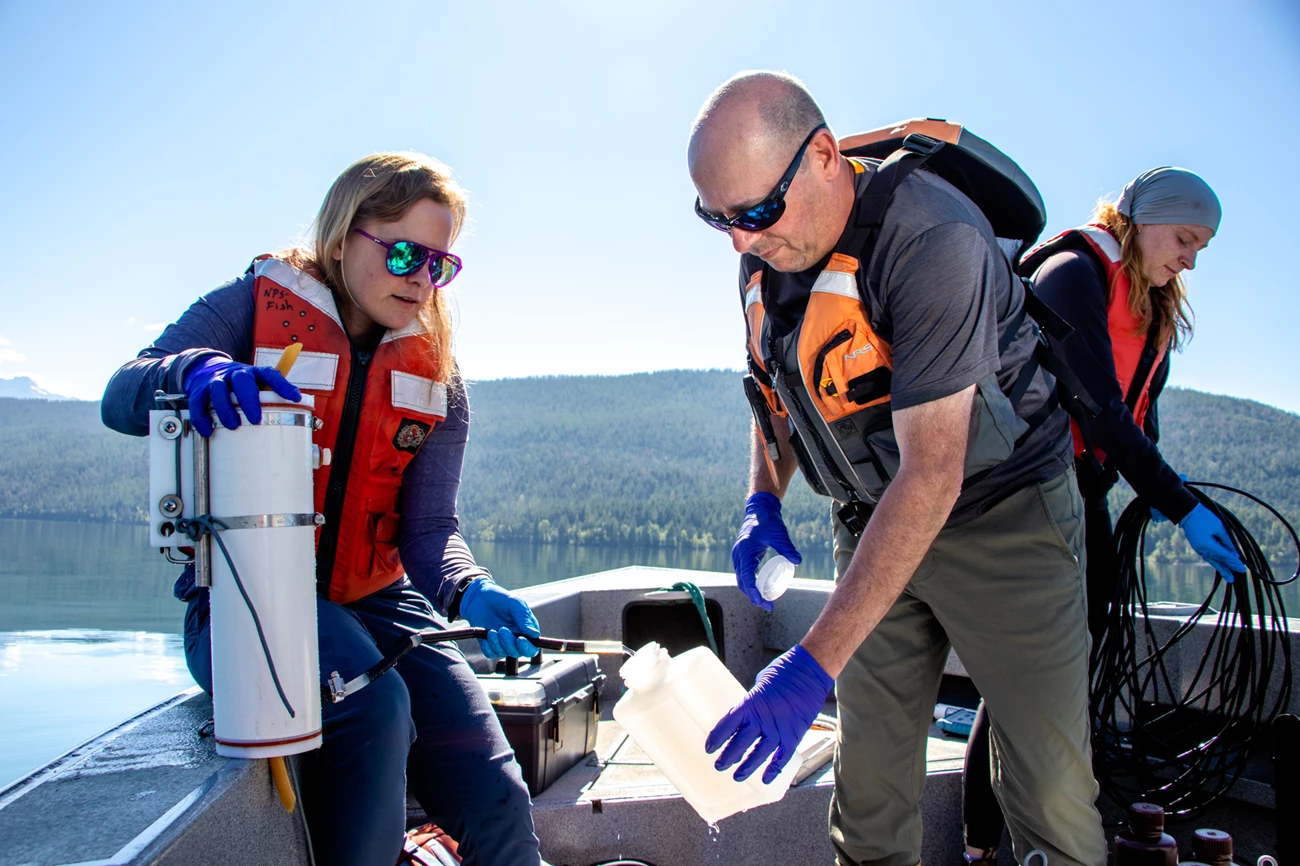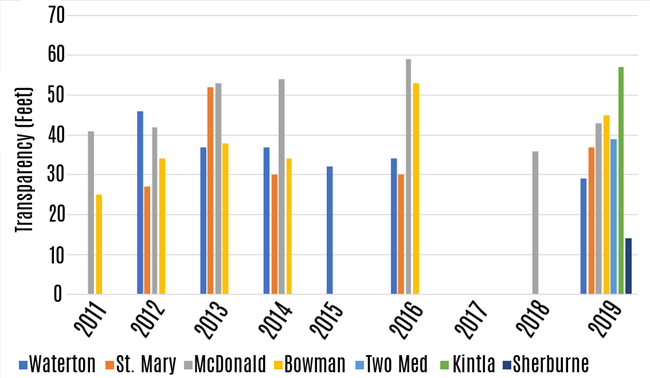Last updated: July 14, 2024
Article
Water Quality Resource Brief
Background Information

NPS/Kristin Vinduska
Threats
The park’s waters are vulnerable to impacts from outside and inside the park such as recreational activities, mining, and development. Climate warming affects water temperature and timing of spring runoff threatening the cold-water ecological systems and the processes that rely on them. A continuing threat to water quality is the transport and deposition of airborne contaminants. Mercury, phosphorus, nitrogen, and ammonium are monitored for any change. Another contaminant of concern are microplastics which are classified as plastic segments less than 5mm. In 2021, an initial investigation documented evidence of microplastic pollution in Lake McDonald. The ecological implications of microplastics in freshwater systems are unclear with many questions, like impacts on food webs, to still be answered.
Water can provide habitat, quench thirst, create power, offer a medium for recreation, and is essential for life to flourish. Glacier National Park is home to the headwaters of the North American continent. From majestic Triple Divide Peak, water travels north to Hudson Bay, west to the Pacific Ocean, and south to the Gulf of Mexico. Monitoring the quality of water in the headwaters of the park helps us to have a better understanding of what changes and processes affect its quality downstream. Water quality is reflective of activities taking place upstream of surface waters.
The water in Glacier includes 762 lakes (amounting to 25,622 acres) and 563 streams, which traverse a total of 2,865 miles. Glacier’s water receives the highest level of protection under the Clean Water Act (CWA). The Montana Department of Environmental Quality oversees the implementation of the CWA, and the State of Montana sets the water quality standard for each water classification level (A-C). Most of the park’s waters are classified by the state as A-1. This is a non-degradation standard with specific limits on contaminants such as bacteria and strict limits on human induced changes to pH, water temperature, and other parameters. Water quality must be maintained in these waters to support the state-designated beneficial uses for each lake including drinking (basic water treatment), salmonid fish growth and survival, bathing, recreation, and more.
Status and Trends
Glacier National Park works with many partners to monitor water quality parameters across the park. The United States Geological Survey (USGS) monitors water quantity and quality on the North Fork of the Flathead River. The National Park Service, through the NPS Vital Signs Network also monitors water quality on the North and Middle Forks of the Flathead River as well as at “sentinel” sites located within the park. The waters assessed in Glacier National Park indicate that water quality remains high in the park.
Most water quality parameters are within the normal range expected for a national park located in northwest Montana, but researchers have highlighted water temperature as a key indicator of ecological health. Water temperatures continue to warm and warm-water tolerant aquatic invertebrate species have increased over the last 15 years of monitoring. However, the North Fork continues to maintain a diverse and healthy aquatic insect community dominated by pollution sensitive species. The park has routinely tested for bacteria (E. coli) at seven sites along the North and Middle Fork of the Flathead River to check for potential septic contamination and/or improper human waste disposal. The results of this testing showed levels were well below human health standards and indicative of clean water.

NPS/Chris Downs
Lake McDonald and other large lakes in the park are monitored for water quality components. Bacteria monitoring in Lake McDonald shows low levels of contamination, indicative of very clean water. Secchi disk depth measurements which measure water transparency are collected annually by park staff across various park lakes. Increased nutrient pollution causes algal growth reducing water transparency. The Secchi depth measurement results show that water in Glacier National Park has some of the highest water quality in the Flathead River Basin when compared to other lakes in the area at similar times of year.
Researchers are currently collecting data to create a nutrient budget for Lake McDonald and evaluate changes in nutrient concentrations over time. Results from a 2018 NPS survey showed that concentrations of phosphorus and nitrogen had major increases in the lake over a roughly 30-year period. Increases in these nutrients could cause excessive algal growth which would impact the ecological integrity of the lake.
Other monitoring in the park looks at contaminant deposition. Elevated mercury levels in fish, due to in large part to increased atmospheric deposition from industrial sources, has been documented in park waters. However, recent studies by park staff and researchers suggest that currently, mercury is unlikely to be having a negative impact on park wildlife. Presence of microplastics are expected to be of increasing concern in the future.
Management Strategy
Glacier National Park will continue to monitor for water quality changes and keep protections in place under the Clean Water Act with the goal of meeting the State of Montana’s standards for A-1 waters. Monitoring systems can be used to understand patterns of contaminant deposition and potential impacts to the natural systems of the park. Water quality is one of the park’s benchmark monitoring initiatives under the NPS Vital Signs Monitoring Network.
The park takes actions to protect the natural integrity of Glacier’s waters in part by combatting the introduction of aquatic invasive species through an inspection and permitting system, carrying out efforts to remove non-native fish species and restock native fish, and educating visitors on responsible recreation by properly disposing waste to reduce water pollution. With continued management efforts, Glacier National Park will serve as an important source for the headwaters of the continent for generations to come.
Resources For More Information
Glacier National Park Staff
- Chris Downs, Fisheries Biologist
- Mark Biel, Natural Resources Program Manager
Documents and web sites
- NPS Water Quality subject site — https://www.nps.gov/subjects/protectingwater
- Rocky Mountain Inventory & Monitoring Network Steam Ecological Integrity — https://www.nps.gov/im/romn/stream-ecological-integrity.htm
- USGS Water Quality Data for the Nation — https://waterdata.usgs.gov/nwis/qw
- Glacier National Park Water Quality — https://www.nps.gov/glac/learn/nature/waterquality.htm
The Crown of the Continent Research Learning Center
Phone: 406-888-7894, Email: kylie_caesar@nps.gov
Website: Crown of the Continent Research Learning Center (U.S. National Park Service) (nps.gov)
